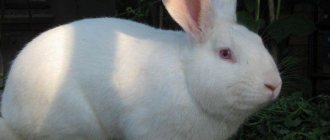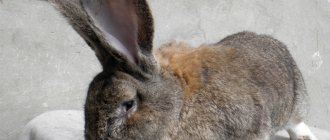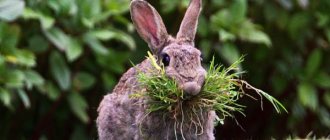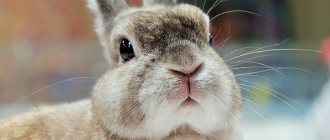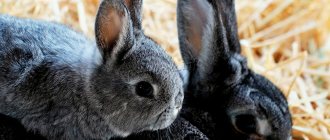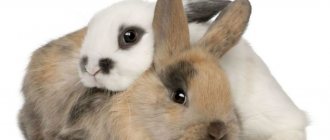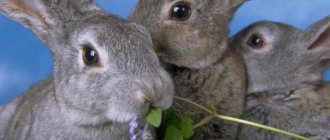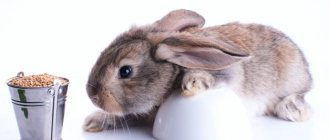Keeping rabbits outside in winter
Only owners with extensive experience know about the benefits of keeping these cute animals outside all year round. Beginning rabbit breeders should remember the following advantages:
- frosty and fresh air helps to harden rabbits and strengthen the immune system;
- financial expenses are much less - arranging a queen cell and cages for winter, as a rule, costs much less than building a full-fledged barn.
- throughout the entire winter season, all kinds of infectious diseases will not make themselves known;
- in winter there is no ammonia fumes, and the animals will not inhale toxins.
Practical recommendations
Practical experience shows that rabbits feel great in outdoor cages in winter. However, measures that help improve the conditions of animals in different climates should not be overlooked. Because there is no absolute guarantee that animals will be able to withstand sub-zero temperatures during the winter season and will not die if certain conditions are not met.
In cold weather, rabbits mate very poorly. Along with this, they begin to actively gain body weight, which is required to warm up. As a result: a significant decrease in reproductive function, low birth rates. Under these conditions there is no hope for any kind of replenishment and productive breeding.
In extreme cold, female rabbits do not feel well during pregnancy. But there’s nothing so scary here either. It happened that the animals easily withstood 20-degree frosts. The fluffies felt quite normal at the same time. It all depends on the literacy of the arrangement of their home.
Insulation of the rabbitry
It is necessary to approach the issue related to the insulation of a rabbit’s home with special care. Ideally, the space between the cages and the walls should be filled with natural heat-insulating materials. These include:
- dried leaves of bushes and trees;
- straw;
- Styrofoam;
- felt;
- small tree branches;
- pieces of moss.
If you have a rabbitry with a mesh floor, it is recommended to cover it with straw. Thick wooden pallets can be placed in the cages. On days of frost, the eared animals’ home can be covered with some things, for example, unnecessary blankets with cotton filling.
Experienced rabbit breeders fill the voids with hay. When animals breathe, they heat the air, the heat from which is transferred and stored by the hay.
The external surfaces of rabbit houses can also be insulated. For this purpose, the top must be covered with overlapping iron sheets. This design will also prevent water from entering the cage.
Breeding Features
In winter, the most resilient rabbits are born, which have strong immunity and grow quickly. In the future, such animals will produce very productive female rabbits and breeding rabbits.
Reproduction in winter must be carried out in accordance with a certain regime. Remember that for covering it is better to take an older female, which you have repeatedly used in litters
Pay attention to her ability to breastfeed
It is advisable to start mating on days of mild frost and during the daytime.
Arranging your home for the winter
This issue is very important when keeping rabbits in winter and should be given maximum attention. It is best to fill the space between the cage and the walls with natural heat insulators. These include:
- Foam or felt;
- Small tree branches;
- Moss;
- Dry straw;
- Dry leaves of bushes and trees.
If the floor has a mesh structure, then it must be covered with a very thick layer of dry straw. You can also lay out the floor in the cage with thick wooden boards. On days when bad weather and frost are severe outside, you should wrap your pet’s cage well with warm clothes or a cotton blanket. Almost all experienced rabbit breeders fill the internal spaces with hay. While breathing, rabbits heat the air and this heat, thanks to the hay, is stored for a long time.
The easiest way to help keep cages warm and cozy is to raise them to a height of 85 centimeters above the floor. The houses can also be insulated on the outside. To do this, place iron overlapping the roof. This will prevent water from getting inside.
Keeping chickens and rabbits together
In cases where it is not possible to keep rabbits and chickens separately, you should ensure the most comfortable conditions for each “neighbor”:
- allocate and fence off a separate area for eating. Rabbits should not have access to the bird feeder, and vice versa;
- take care of acceptable temperature conditions: eliminate the possibility of drafts, avoid overheating and excessive cooling of the enclosure;
- allocate an individual place for sleeping: rabbits must have their own closed corner for rest, and the bird must be sent to a special closed enclosure to roost at night;
- exclude the cohabitation of two male rabbits together: in this case, not only the chickens, but also the furry animals themselves will suffer and be bitten;
- There should be no more than a dozen chickens for every 2 rabbits - otherwise the rabbits will become irritable, lose sleep and appetite, and show aggression.
Video: keeping chickens and rabbits together
In any case, the cohabitation of rabbits and chickens will cause inconvenience: such a neighborhood will irritate the animals, frighten them and disrupt their natural behavior. It is best to keep these pets separately, and only in cases of extreme necessity, taking into account all the nuances and subtleties of keeping, can you combine the pastime of these animals.
Did you know? The largest breed of chicken in the world is Brahma. The average weight of one laying hen of this breed reaches 5 kg, and the average egg production is about 250 eggs per year. The largest rooster in the world also belongs to this breed: its weight is 11 kg and its height is 91 cm at the withers. This giant lives in Somerset (UK) and is famous for single-handedly driving wild foxes away from his hen coop.
Try to create maximum comfort for the animals, taking into account all the recommendations given, you can provide your pet rabbits and birds with a completely tolerable coexistence
Winter births in rabbits
Rabbits are one of the most commonly used domestic animals for breeding. Most often, individuals are kept for subsequent slaughter and sale of meat and skin products. From the point of view of profitability in monetary terms, rabbit breeding is a very profitable business.
The animals are unpretentious both in terms of keeping conditions and in the food supply (most breeds), but despite this, if the conditions for childbirth are poorly organized, the farm will quickly deteriorate.
How to check the result
The female's pregnancy can be determined 10-12 days after the “date”. The animal is positioned with its head towards itself, held by the withers with one hand, and the lower part of the abdomen is carefully probed with the other. During this period, the fertilized uterus can be felt as an oval-shaped compaction in the pelvic area.
Behavior changes: the female in the cage behaves calmer, her appetite improves, while she may be wary of the owner and not give in to the hands. During the control replanting, the pregnant female will not allow her partner to approach her.
Did you know? In Australia, it is not recommended to keep rabbits as pets, and in the state of Queensland it is even prohibited by law and faces a fine of up to 30,000 Australian dollars.
How long pregnancy lasts in rabbits depends on the number of embryos. It usually lasts about 30 days; The larger the litter, the shorter the pregnancy. During this period, the rabbit needs peace, comfort, the absence of high humidity and drafts, good nutrition, mainly succulent food, and a sufficient amount of water.
For successful mating of rabbits, it is necessary to take care of the animals, create comfortable conditions for them, and observe their behavior in order to choose the optimal moment. If you follow these principles, you will definitely achieve your goal.
How to keep rabbits outside in winter
Keeping rabbits outside in winter is a very responsible process. With the onset of the first cold weather, rabbit breeders should take care of preparing their animals for winter.
A certain time of year dictates its own conditions regarding the nuances of content, and if you know about them, seasonal differences will not cause unnecessary trouble. Despite the fact that rabbits have natural protection from the cold in the form of thick fur, in artificial conditions this protection is not enough.
Keeping rabbits outside in winter
A decrease in temperature can lead to severe frostbite and other diseases, so all concern for the comfort and maintenance of rabbits outdoors in winter falls on the shoulders of the farmer. During the cold season, rabbits continue to live their lives, but knowing some features will help maintain their health. Breeding rabbits in winter requires taking into account certain diet rules and special heating conditions for enclosures.
What breeds of rabbits are best suited for breeding in winter?
When choosing a breed for breeding, you first need to understand what line of business you have. All breeds of rabbits are divided into:
- meat;
- fur;
- sandpaper;
- decorative.
Read also: Dishes made from pak choy
Attention should also be paid to the climatic conditions of your area. It is best to purchase a particular breed from a nursery. There you can also get advice from specialists regarding the frost resistance of a particular breed.
But here it is necessary to stipulate that this concerns the meat direction. They are identical in size to Flanders, but are more resistant to low temperatures and are unpretentious in food and maintenance. And the breeds are distinguished by remarkable fertility - from 10 to 12 rabbits in one litter. But even for them, the very low temperatures that rabbits usually endure in burrows are not suitable, because, as practice shows, such burrows are best dug by average rabbits.
What can a rabbit get sick with in winter?
As you already know from previous articles, rabbits practically do not suffer from viral infections in winter and winter epidemics are more nonsense than reality. But the likelihood of diseases associated with hypothermia in animals increases sharply.
Despite its warm “fur coat”, in severe frosts over twenty, especially in open cages and especially in a draft, the rabbit experiences a feeling of cold. It's not far from frostbite. Most often, according to statistics, the ears and paws of animals are affected. Rabbits born on a frosty night often freeze, despite the titanic efforts of the mother.
A frostbitten rabbit can be identified by its restless behavior; the animals begin to scratch the affected areas of the body and take an unnatural pose. With severe frostbite, they become lethargic and depressed. An experienced farmer often looks into the cages during the cold season and monitors the condition of his pets.
- The first is when redness appears in a separate area and swelling of the skin is visible. In this case, the animal is immediately transferred to a warm room, its affected areas are carefully lubricated with animal fat. The application of warm objects and various heating pads is prohibited.
- The second is when small bubbles with liquid are visible. In this case, you will already need camphor oil, which is used to treat areas of the skin after opening the blisters.
- The third stage is only possible if the rabbit is exposed to very low temperatures for a long time. In this case, the skin dies, wrinkles and then dries out. You cannot do without professional veterinary help here.
Please do not confuse a rabbit’s common cold with infectious rhinitis. Signs of the disease include nasal discharge in the form of mucus, periodic sneezing, lethargy and apathy, decreased appetite or refusal to feed at all. The whole difference is in the color of these discharges. If the color is greenish or whitish, then your rabbit most likely has an infection. If the snot is clear, without signs of pus, your rabbit simply has a cold.
Breed characteristics
Animals that do not have a specific breed endure the winter best: young animals from such rabbits show the highest survival rate. Then we can name the breeds adapted to the conditions of the middle zone: Soviet chinchillas and Viennese blues. Gray and white giants are least suitable for breeding at low temperatures.
Soviet chinchilla
In order for winter births to go well, you must follow the recommendations given in this article. To reduce the risk of freezing of young animals, it is recommended to organize round-the-clock duty on the farm and do not forget to monitor the behavioral characteristics of the animals. If the young animals fall out of the nest, then the rabbits need to be returned there, but at the same time remember that they can only be handled with clean hands, which should not have any foreign smell.
We invite you to join our Zen channel and group on VKontakte or Odnoklassniki, where new articles are published, as well as news for gardeners and livestock breeders.
Similar articles:
- Breed overview: Russian ermine rabbit
- Coniferous branches in the winter diet of rabbits
- Should you give zucchini to rabbits?
How to determine the age of a rabbit?
Rabbits are becoming more and more popular now. Many people keep ordinary and decorative rabbits at home, or decide to breed them for meat or skins. Regardless of what the rabbit is purchased for, it would be nice to know how to determine the age of the rabbit.
Of course, it is impossible to determine the age exactly; even experienced veterinarians do this only approximately. Another thing is that an approximate estimate will be quite enough. A number of signs allow us to approximately determine the age of a rabbit.
By the way, if rabbits were purchased for fur, then the age at which rabbits were slaughtered for fur will also have to be determined.
In this case, the most important thing is to know whether the rabbit you have is an adult or a very young one, since they molt differently.
Firstly, in small rabbits, up to 6 months of age, the ribs are quite soft, which allows you to immediately identify small rabbits. And after a year, their teeth become covered with plaque and turn yellow. The more stains on a rabbit's teeth, the older it is.
You can tell a lot by the length of the claws. In rabbits they constantly grow and quickly begin to bend inward. However, unscrupulous sellers may trim their nails to hide their age. So you shouldn’t buy a rabbit with its claws cut.
A rabbit's eyelids also change with age. Initially they are smooth and clean, but over time they sag and swell and become lumpy. But the size and weight of a rabbit can in no way be the answer to the question of how to find out the age of a rabbit. The fact is that different breeds of rabbits have different weight and size standards. And young rabbits of some breeds reach the same size as adult rabbits of other breeds.
It is especially dangerous to focus on size if you plan to purchase a dwarf, decorative rabbit. Very often, sellers pass off young ordinary rabbits as adult dwarf rabbits. How to determine the age of a decorative rabbit?
About the same as usual: on the ribs, teeth and eyelids. However, a number of other features can be used. For example, the length of the ears. In decorative rabbits it is initially quite small: 3.5-5.5 cm, maximum 7 cm, but no more. Long ears are a sign of young animals of ordinary breeds.
With young animals, everything is somewhat more complicated, since their molting depends not only on the season, but also on age. Their first molt begins a month after birth. Subsequent molting largely depends on the time at which the rabbits were born.
In adult rabbits, it is enough to remember when seasonal molting begins and ends. They begin to shed in March. Throughout the spring and summer, their fur is sparse and short. When slaughtered in summer, it will be possible to obtain a skin of no higher than grade 2. The next molt in rabbits begins in September-October and ends in November. Rabbits' fur in winter is longer, thicker, and more beautiful. It is from November to March that it is worth slaughtering an adult rabbit for fur.
In general, it is better, after all, to purchase a rabbit not at the market or a regular pet store, where even the seller’s assurances about a particular gender and age of the rabbit mean nothing, but in nurseries or from professional breeders. In this case, the buyer will receive documents indicating the gender and exact age of the rabbit.
Difference between winter and summer litter
There is no consensus on the optimal time to breed rabbits. However, most rabbit breeders consider it more suitable to conduct mating at home in the winter.
During the winter birth, the cubs grow stronger
The only argument of opponents of breeding in winter is that it is cold at this time of year. However, thanks to their warm and thick coat, rabbits tolerate cold much better than heat.
Winter births differ from summer ones in terms of timing. In summer - 2-3 days less.
They are also not as numerous as summer ones, which is their disadvantage. But the offspring are born stronger, and the survival rate is slightly higher. It is also worth noting that frost kills many pathogenic bacteria. Summer is the most favorable time for rampant infections.
As for off-season births, spring ones are much preferable to autumn ones. The best time is considered to be early spring. At this time, the warm sun has already appeared, but the air temperature remains low enough to contain infections. In addition, in early spring the first grass begins to appear, which makes feeding the young animals cheaper. In the fall, the weakest offspring are born.
Read also: What kind of horns does a bull have: anatomy, what they are used for, whether they grow back
In order for births planned in winter to be successful, rabbits and female rabbits should be given rest in the fall.
Arrangement of the cage
The first time you look at them you wonder how to eat them.
If you need healthy and living offspring, then arrange warm cages for pregnant rabbits, queen cells, where in the future there will be a female rabbit with small rabbits. If you wish, you can arrange the cages yourself.
Buy hardwood planks. Make the boxes so that the boards fit tightly together. Make the lid removable. Equip one of the side walls for a manhole; to do this, cut a hole measuring 15 by 15 cm. Finally, cover the structure with thermal insulation sheathing.
Use available materials as insulation. For insulation, film or roofing felt, thick cardboard, or roofing felt will work well. The cages on the street are covered with snow from above.
Don’t skimp on the bedding, but insulate the screen doors with the same straw (straw mats) or burlap. After cleaning and disinfecting the cage, 2-3 weeks before breeding, apply a thick layer. A week before the event, add soft hay to the cage.
In some cases, additional heating becomes necessary. Use water heaters inside the cage and electric heaters outside.
Content Features
Of course, for the comfortable existence of domestic animals, it is desirable for each individual species to have its own territory - this helps to maintain a sense of security in the animals and their peace of mind.
Important! Not all breeds of rabbits can be kept outdoors year-round: in severe frosts, most of them need additional heating - for this they are moved to special heated cages, or sheds.
Rabbits
Chickens are demanding in terms of living conditions: it is important for them to have a large space for walking and good hygienic conditions; sensitivity to the cleanliness of the enclosure and the air: they do not like dirt, and dust particles and an abundance of fluff in the air contribute to difficulty breathing; demands on the cleanliness of the drinker and feeder: food debris and rotting vegetables must be removed daily, and the cage or enclosure itself must be cleaned of waste at least once a week; sensitivity to drafts; the need for a special straw flooring that does not contain sharp stones or hard pieces of soil: the animals have fairly delicate skin and are often injured by sharp objects; need for a balanced diet: the basis of rabbit nutrition is specialized food, some fresh vegetables and fruits (carrots, beets, apples, etc.); maintaining the correct temperature regime: in extreme heat, the rabbit is at risk of overheating, which will cause serious illnesses. To avoid this, a special canopy is installed in the enclosure, which protects the long-eared animals from the scorching sun. undemanding to living conditions: the bird does not suffer in cramped spaces or without access to fresh air; insensitivity to the cleanliness of the poultry house: chickens feel good even in an uncleaned room; the need for sufficient lighting: in poor light, laying hens lose their appetite, become weaker, and egg production decreases sharply; the need for additional insulation for the winter period: in winter, in addition to good lighting, laying hens need to insulate the house with hay or straw - this will help avoid hypothermia; the need for a balanced diet: the basis of nutrition for laying hens is hay and straw, grain, cooked cereals, and some vegetables; need for small pebbles, dust and ash
Laying hens love to bathe in dry soil and ash - this saves them from parasites in their feathers, and small pebbles are necessary for laying hens to better digest food: birds swallow them, and the food, rubbing against stones in the stomach, is better absorbed; the need for a special fenced-off place intended for overnight stay.
Differences:
- Rabbits, by their nature, are quite peaceful creatures that do not show aggression and alternate active pastime with quiet rest in the shade. But the way of life of chickens is very active: they are constantly on the move, looking for food or simply taking walks in the sun.
- If chickens like to dig in the dust and do not feel constrained in conditions of limited movement, then for long-eared animals such an environment is accompanied by stress and even diseases. Learn how to properly keep ducks and chickens together.
- These pets also have excellent diets: the menu for laying hens includes boiled food - potatoes, boiled corn and some cereals, but such food is contraindicated for rabbits.
- Temperature conditions for rabbits and chickens also differ: if the poultry house must be insulated for winter, then some cold-resistant breeds of eared birds (New Zealand White, Burgundy, California, etc.) begin to feel unwell at temperatures that are too high for them - they do not require additional insulation .
Video: keeping chickens and rabbits togetherCommon features:
- What rabbits and chickens have in common is the ability to move: both laying hens and long-eared animals love to walk in open spaces. But if the chickens perceive the restriction in movement as normal, then for the long-eared it will cause serious discomfort.
- Both of these types of pets need a separate place to rest: for rabbits, this is a small house for an afternoon nap, and for laying hens, a furnished pen for sleeping at night.
- Despite the fact that laying hens are not demanding in terms of cleanliness, cleaning the poultry house, feeders and drinkers is also a mandatory procedure: bacteria that multiply in food debris are the causative agents of some intestinal diseases (heteracidosis, worms, salmonellosis, etc.).
You will be interested in reading about how to determine the sex of a rabbit, what they eat and what to feed rabbits in winter, when you can allow a female rabbit to mate, as well as how long it lasts and how to determine the pregnancy of a female rabbit.
The importance of proper feeding in winter
A varied and balanced diet is important for long-eared jumpers at any time of the year, and especially in winter, and constant access to clean water is mandatory. Since their digestive system is weak, they need to constantly chew something, such as hay or branches.
Read also: Amur steppe polecat photo and description
When making hay, it is better not to take grass at all that you are not sure about, and lilies of the valley, crow's eye, larkspur, buttercup, hellebore, milkweed, poisonous weed are pure poison for them.
Consider the diet of rabbits in winter.
Roughage:
- branches of fruit trees - antibacterial and vitamin feeding;
- hay from wormwood, burdock, plantain, sow thistle, clover and wheatgrass.
- boiled cabbage and potatoes + potato peelings;
- carrot;
- kale;
- sugar beet;
- pumpkin.
Concentrated feed:
- bran;
- cake;
- feed;
- cereal mash;
- meal
Vitamin and mineral supplements:
- actually vitamins and minerals that are added to warm mixed food;
- bone flour;
- fish fat;
- dried or dried rose hips, rowan berries;
- needles;
- nettle hay and sprouted grain.
Correct replanting
When replanting offspring, it is necessary to take into account the age difference between different offspring, restrictions on the number of rabbits added, and also adhere to strict rules when replanting cubs with someone else's female.
It will probably be useful for you to consider the causes of miscarriages in rabbits.
What age difference is allowed between rabbits?
The greatest likelihood that a female rabbit will accept someone else’s offspring exists when the age difference between her own and someone else’s rabbits is no more than 2–3 days. If the age difference is greater, then the likelihood of success decreases. However, often everything depends on the qualities of a particular female.
There are cases described when she easily accepts newborn rabbits, even though her own are already 1–1.5 months old. If the rabbit has already received other people's cubs, then a new replanting, as a rule, is problem-free.
We advise you to familiarize yourself with the reasons why the mother rabbit abandoned her rabbits.
How many kids can you place?
The number of cubs placed with someone else's female should not exceed the number of rabbits already being fed. A female who has given birth for the first time can usually feed no more than 8 cubs without problems, and one that has given birth more than once can feed up to 12–13 cubs.
Of course, these indicators also depend on the condition and characteristics of the body of the rabbit herself, but when placing someone else’s offspring, you can focus on them as the limiting value. It is optimal to feed no more than 8 babies - according to the number of nipples. To stimulate the female's lactation, the proportion of succulent food in her diet is usually increased.
Find out in more detail all the features of the care and maintenance of newborn rabbits.
How to place baby rabbits with another female rabbit
To successfully transfer offspring, you must perform the following steps:
- Hands are washed with soap.
- The female is removed from the nest, temporarily placing her in another place.
- They collect fluff from the nest and rub it on the adopted animals. The treated babies are placed in the nest in such a way that they are surrounded on all sides by their own female rabbits.
- The nested cubs are sprinkled with down from the nest on top.
- After 1–1.5 hours, the female rabbit is returned to the nest.
Video: how to place baby rabbits with another rabbit
Birth of a female rabbit
The birth of a female rabbit is a litter. A pregnant female is called a pregnant female by rabbit breeders. For breeding, she requires a high-quality queen cell, which is prepared by the owner. The female rabbit will arrange the nest herself.
The queen cell must be of sufficient size so that the female rabbit can move normally in it even after the rabbits grow up. It is important that it is properly closed on all sides and only a hole remains for the female to enter. It is convenient to make the roof of the queen cell on hinges. Soft hay is best for bedding.
Read also: Determining the hunting period for female rabbits
The approach of childbirth is indicated by the fact that the female begins to prepare the nest. She actively plucks the fluff on her belly and chest and covers the bottom of the queen cell with it. From this time on, you need to watch the rabbit especially carefully.
Actions of a rabbit breeder
After the female rabbit has given birth to all her offspring and has emerged from the queen cell to drink and eat, the owner urgently needs to complete 2 tasks.
Removing dead rabbits . An experienced female most often herself rejects stillborn young and eats them along with the placenta. When this does not happen, the owner throws out such rabbits. If a female rabbit gave birth to dead rabbits, you need to pay attention to her health and what kind of care she received during pregnancy.
Livestock counting . If a female rabbit has given birth to more than 10 young rabbits, and there are lactating females on the farm with fewer cubs, it is better to transfer part of the offspring to them. Newborn rabbits need a large volume of milk.
It is important to do everything quickly and quietly, and so that the female does not see this, for which the entrance to the queen cell is closed during the manipulations. In order not to introduce foreign odors into the nest, due to which the female rabbit will most likely abandon her offspring, it is important to first thoroughly wash your hands with warm water without using soap.
Barley should be included in the rabbit’s diet, as it improves the animal’s lactation. The temperature in the rabbitry should not fall below +18 degrees.
Common mistakes when organizing winter births
It is important for novice rabbit breeders to know the basic rules for raising livestock in winter in order to avoid common mistakes:
- You should not leave a female rabbit in a cage with a male for a long time. But quickly taking it away when coverage has not yet occurred is also a mistake. Fertilization is best done in the daytime for 3-4 days;
- Often they mistakenly take very young, inferior males for mating. They fail to cope with the task, and productive time is simply lost;
- after giving birth, you need to carefully inspect the nest and check that there is enough water, otherwise the female may eat her droppings;
- you should not deplete the uterus with very frequent litters, especially if the food does not contain all the necessary components;
- It’s a very big mistake to feed rabbits, and especially females at startup, with compound feed prepared for cattle.
Winter calf: video
Behavior of a female rabbit before giving birth
The behavior of a female before giving birth differs from the traditional one. If in a normal state the female rabbit behaves calmly and quietly, then when the birth approaches, she becomes restless, anxious and even aggressive.
Hereby
A rabbit's pregnancy causes changes in her behavior.
She:
behaves aggressively towards the male: does not allow him to approach him, may attack or bite, avoids sexual contact with him in every possible way;
becomes more cautious and fearful;
begins to build a nest. The arrangement of the nest during real pregnancy begins several days before the expected birth, on the 26th–27th day
The female pulls out the fluff from herself, lines it in the nest, and hides in a secluded place. At this time, she can behave aggressively and not allow her owners to approach her;
eats heavily. A pregnant female begins to eat much more, drink a lot of water, and becomes more demanding of food.
False
In rabbits, there is such a thing as a false pregnancy, when mating has occurred, but fertilization has not, and the animal behaves in the same way as during a real pregnancy:
- reacts aggressively to others;
- does not allow the male to approach him;
- begins to build a nest;
- worries and hides from the owner.
It is almost impossible to distinguish a false pregnancy from a real one in the early stages. However, if the female begins construction of the uterine nest quite early, already in the second week, then, most likely, fertilization has not occurred.
As a rule, this condition lasts about two weeks while the corpus luteum acts. After this, the rabbit calms down and behaves as usual.
Breeding rabbits in winter
Despite the fact that the cold has a soporific effect on pets, reducing their activity, breeding does not stand still. If a baby rabbit was born in winter, then it has a number of advantages over those born at other seasonal times. Among the main advantages are:
- hardening, which strengthens the immune system, so rabbits rarely get sick;
- increased growth;
- high quality and thick fur.
Rabbits born in winter are subsequently more suitable to give birth to offspring. Their fertility is significantly higher than that of other individuals.
Mating of rabbits is carried out according to a specially developed regime:
- It is better to mate pets during the day, when it is warm outside and there is no frost.
- A female rabbit is selected that has already given birth to healthy offspring more than once. This is due to the fact that only such a female can feed all the offspring.
- Rabbits should not be handled frequently; they should rest and gain strength. Otherwise, you can harm their health.
Differences in winter litter
In winter, giving birth is possible, although reproduction during this period is not the main goal of rabbits. You should be responsible about which rabbits you will breed.
They also pay a big role to the equipment of the queen cell, where the female rabbit will feed the cubs. A properly made queen cell will allow the female to raise healthy and high-quality offspring.
To properly equip a queen cell, you should know the rules:
- The cages in which mating will take place must have additional insulation. This will allow partners to be more active. That is, the main goal of the breeder is to maximize the conditions for mating.
- The queen cell must have a lighting system so that it is daylight inside most of the time.
- Partners are given warm water and food.
Breeding rabbits outdoors in winter should be done with special care and attention. Only then will individuals produce full-fledged offspring, which will subsequently bring good profits
How to equip a queen cell
As already noted, in winter it is quite difficult to carry and feed small rabbits. That is why a special place is occupied by the arrangement and insulation of the queen cell. Rabbits can give birth even at -25 degrees, however, newborns are unlikely to survive in such cold weather. To prevent the death of the babies, the cells and queen cell are strengthened and insulated in advance, when winter has not yet arrived.
The insulation of the queen cell should be carried out, guided by the following recommendations:
- The place where the rabbit and her offspring will be kept is insulated on all sides using polystyrene foam.
- There should not be the slightest gap through which a draft could leak.
- If the floor is a mesh, then a dense material (cardboard, oranite) is placed on it.
- A soft bedding is required that is placed on the floor.
It is important that the queen cell be equipped with a ventilation system. In addition, the queen cell must always be clean and disinfected, since any microbe can cause a dangerous disease in rabbits
Even at -20 degrees, the female will give birth to babies, so there is no need to be afraid of such marks on the thermometer.
However, if the birth was successful, this is not a guarantee that the rabbits’ offspring will survive. Inappropriate care from the mother can provoke the death of babies. The nervous state of the female rabbit, as a rule, does not allow her to fully monitor and care for the cubs.
In addition, the female is obliged to warm the offspring with her fur. If this does not happen, then the rabbits need to be rescued urgently, otherwise they may freeze. To protect baby rabbits from the cold, you need to do the following:
- build a nest and place it in a cardboard box;
- put something soft on the bottom;
- the temperature should vary from 33 to 35 degrees. You can increase the temperature using a lamp or bottle filled with hot water;
- the female should breastfeed her babies several times a day;
The baby rabbits stay in the nest until they are 2 weeks old. After that, they are put back to the rabbit.
Breeding rabbits - breeding rules from a specialist
Rabbit breeding is one of the simplest areas in animal husbandry. These animals are very unpretentious, it does not require much knowledge and experience to observe them, food can be found in any specialized store (there will be no questions about what to feed the rabbit). Rabbits are extremely fertile and one female rabbit produces enough meat, offspring and skins per year to cover expenses and make a profit.
Newborns lie on top of each other
On specialized farms and rabbit breeding farms, workers create the necessary conditions for breeding and keeping small rabbits in winter. But at home and in gardens, owners must equip everything with their own hands. It is impossible to do without taking these points into account, despite the fact that rabbits are particularly unpretentious, they are susceptible to the influence of external factors. And without your help they won’t be able to cope on their own in a cold cage.
Read also: Diet of goat kids: how to feed them correctly
Technology for raising rabbits in pits
The problem with new breeds of rabbits is low immunity. Animals have become sensitive to external factors and often get sick. Using pit housing as close to the natural environment, rabbit breeders want to return long-eared rabbits to their former stamina and resistance to disease. Also, many breeders believe that this method is more humane for rabbits.
How to choose the right breed
To decide on the breed of rabbits to keep in pits, you should first decide whether the animals will be raised for meat or for skins. Well, you need to choose among breeds that have been time-tested and acclimatized to the local region.
| Recommended breeds of rabbits for pit housing | |||
| Meat direction | Selfish direction | ||
| Rex | The breed requires close care, but the animals are pleased with their rapid growth (adult weight is almost 5 kg), and the quality of the meat is simply excellent. An excellent option for keeping in pits. | Vienna Blue | They are famous for the quality of their wool and their resistance to temperature changes. Rabbits in the pit reproduce and grow well. |
| Flanders | The weight of the rabbit is up to 25 kg, which is a big advantage. When growing pits, it is recommended to control the quantity - up to 20 pieces per pit are allowed. | Butterfly | They get used to different living conditions very easily (especially in pits). They delight with their original coat colors. |
| Gray giant | They are unpretentious in care, grow quickly, the weight of an adult animal is up to 15 kg. They feel great underground, even when kept with representatives of other breeds. | Risen | Excellent coat quality and a variety of colors are the distinctive features of the breed. Suitable for pit keeping, but at the same time a little expensive to care for. |
Pros and cons of the method
| Positive aspects of Yamnaya housing | Negative aspects of pit content |
| Financial savings (no money is spent on building cells). | If an infection occurs, the entire tribe can become sick and die at the same time. |
| Saves time on care (no need to frequently clean the rabbits' place of residence). | There are some difficulties with cleaning the pits. |
| Minimum space required. | Catching an animal is not an easy task. |
| The fertility of females increases. | Very large breeds with valuable fur are rarely used for pit farming. |
| The meat turns out more tasty than when kept in cells. | Animal inbreeding. |
All negative aspects are very conditional, because with a competent approach they can be easily eliminated or avoided.
What is the importance of winter births?
Many novice breeders decide to breed rabbits, which is associated with the rapid reproduction of rodents, but people do not take into account a large number of nuances. A person can be misled by the fact that in many articles found on the Internet, the reproduction of rabbits is described approximately as follows: the female, after giving birth to offspring and feeding the rabbits, is already ready for the next mating. Pregnancy lasts about a month, and therefore, according to statistics, you can get up to 6 litters in a year.
recommended articles:
- How to keep turkeys in winter?
- How to keep quails in winter?
This practice actually exists in rabbit breeding and is called semi-compacted breeding. If we talk about the realities of this type of animal reproduction, even experienced breeders try not to plan to produce offspring in the winter. Depending on the temperature characteristics of the region (from October to March), a “pause” in production occurs, which leads to six months of downtime.
To increase the efficiency of the farm, you can use compacted litters, which means covering the female already on the first to fifth day after the birth process. This practice has one significant disadvantage, which is the enormous stress to which the animal will be subjected. To maintain healthy livestock, it is recommended to use this type of propagation only in extreme cases.
Newborn rabbits
The introduction of winter litters serves to ensure a more uniform biological potential of the female. At the same time, it is possible to increase the length of time the young animals stay with their mother, which will have a very positive effect on the health of the rabbits. An additional advantage is the good body strength of young animals born in the winter months, the good productivity of such animals, and high-quality skin products. Females that emerge in winter can bear offspring twice this year.
Preparing cells for cold weather
The cages in which your rabbits will winter need to be prepared for the cold. That is, carry out the following operations.
- Insulate the floor. If the cage has a mesh floor, then lay thick boards on top, and put deep bedding on the boards.
- Insulate the door. In order not to impede the penetration of sunlight and not to reduce short winter days, use transparent materials for insulation - plexiglass, polycarbonate or a glazed frame.
- Insulate the walls on all sides. First of all, you need to caulk all the cracks so that snow does not sweep into them and the wind does not whistle. For these purposes, you can use tow and felt. Then cover it with a blanket or any modern insulation. Cover with waterproof material - film, roofing felt, plywood. It is better to insulate not inside the cage, but outside.
In the spring, all insulation must be removed so that fungus does not develop, rot does not spread, and with them infections and pathogenic microbes.
Cell placement
Shed for rabbits
In winter, it is important to use all the possibilities of natural heating from the sun's rays. Therefore, cages with rabbits on the site should be located where the sun lasts longer and more.
And also in a place protected from the wind. That is, behind buildings, preferably permanent ones, and on the south side.
If there are a lot of cells, then they should be placed facing each other, that is, with their doors. Leave a passage one and a half to two meters wide between them. For insulation, you can temporarily build a roof, preferably a gable roof. And at the end of the passages, put doors on both sides. The result will be a temporary, light shad, such as shown in the photo above.
Portable lighting can be attached to the top of the shed. In winter, daylight hours are short. And lighting will help lengthen it. And that means it will be easier to serve the rabbits.
Transferring cells to shelter
In severe frosts, the cells must be moved to a shelter. It could be an unheated barn, garage or greenhouse. If you have a modern polycarbonate greenhouse, then in winter it can be used to house animals, including rabbits. In this case, they do not put cages in the greenhouse, but build an aviary in it. That is, they surround the perimeter of the greenhouse with a net, having first buried it half a meter into the ground. This will save the greenhouse from undermining.
Keeping animals in greenhouses in winter leads to improvement of the soil. In addition, in the spring there is no need for additional fertilizer of the soil in the greenhouse. Rabbits love it there in winter. Female rabbits even begin to dig holes and bring offspring into them.
Polycarbonate greenhouse in which you can keep rabbits in winter
If you move rabbits into a room where other pets are kept, be aware that increased noise can cause stress and even death. Rabbits are very shy and may stop feeding their offspring. If they were sick and you wanted to warm them, then such proximity could aggravate the course of the disease.
In addition, clean and fresh air is very important for them, which they will clearly lack in the barn. There have been cases when one night spent in a gas-filled room led to their death. And places where large pets are kept always have strong ammonia fumes. Therefore, good supply and exhaust ventilation should be organized there.
Timing of puberty in rabbits
Rabbits become sexually mature at the age of 5-7 months. Females of different breeds are ready to mate by the age of five months, and males a little later. Individuals of large breeds mature longer - up to 7 months.
It is not recommended to mate rabbits too early; the animal’s body must become stronger in order to later be able to bear healthy offspring. It is also impossible to overexpose sexually mature animals; delayed mating will affect fertility in the future. The peak productivity of females occurs in the first 1.5-2 years of their life, this must be taken into account.
By correctly determining the appropriate age for mating, the farmer will receive maximum profit. In a year, each female rabbit will bring about 40 cubs, which within six months will become sexually mature and also begin to reproduce.
